New on ASCR Discovery: Laser Focus

Laser physicists are tantalizingly close to building a device that delivers highly focused beams of tumor-killing ionized particles and packing it in a compact unit that would fit in a doctor’s office.
In a few femtoseconds, the laser devices excite electrons in a foil a few microns thick, accumulating laser energy and then transferring it to surrounding atoms, creating ions that deliver radiation to a target. Researchers know that’s what happens on a large scale. The underlying physics, however, occurs in the particles that constitute matter’s building blocks – a scale at which relativistic phenomena can and do affect the outcome.
Physicist Michael Bussmann of the German research laboratory Helmholtz-Zentrum Dresden-Rossendorf (HZDR) hopes to clarify those fine details. The team he leads is creating three-dimensional physics simulations of the particle acceleration process. His computational radiation physics group recently began running the simulations on Titan, a Cray XK7 supercomputer at the Oak Ridge Leadership Computing Facility, using 57 million processor hours allocated through the U.S. Department of Energy’s INCITE program.
“A lot of interesting physics is happening,” Bussmann says. The problem is that researchers can’t always reliably repeat experiments because multiple parameters affecting the outcome constantly change. “It is vital to compare exper imental results to realistic simulations.”
The simulations examine what happens when the laser’s high-energy electromagnetic fields rip matter apart, producing negatively charged electrons and positively charged ions. Separating electrons from ions creates the acceleration fields necessary to give energy to the ions. Long before striking its intended target, the laser pulse enters a plasma state in which the charged particles rapidly interact with electric and magnetic fields in complex ways that can cause instabilities under certain conditions. Bussmann’s team is modeling a series of experimental conditions, including varying properties of the laser pulse and the irradiated target’s atomic composition.
“What we would really like to do is control the whole process,” he says. “As a patient, you would not want to be on the other end of that ion dose that is trying to cure you if there is no control over the dosing. Control, understanding and reproducibility are important for the medical applications.”
Heavier particles like the positively charged ions physics accelerators create have shown promise in delivering intense radiation to tumors while minimizing the radiation scattered to nearby tissue. This ion beam therapy, however, has fallen short of its potential. One serious issue: Producing ions energetic enough to hit tissues deep within the body with therapeutic radiation doses requires a big, expensive device.
At HZDR, Bussmann is collaborating with experimental scientists to demonstrate that a laser-accelerated ion beam can kill cancer cells in the laboratory, as they reported in the New Journal of Physics. At this point, though, the efficiency of laser energy transfer into ion beam energy is too poor to reach deep tissue tumors. Most of the electric energy powering the laser dissipates as heat. At a total efficiency of less than 1 percent, there’s a lot of room for improvement. Bussmann’s group thinks that using modern diode-pump lasers will boost the efficiency by at least a factor of 10.
“Diode lasers are smaller and hopefully easier to control, so we can more easily reproduce experimental conditions,” he says.
The Titan simulations play a crucial role. The group wants to resolve the dynamics based on the fundamental physics – the motion of electrons and ions in ultra-strong fields – while generating a complete picture of the overall acceleration process. They think optimizing the laser parameters and experimenting with the form, structure and composition of the laser targets will help boost the ion beam acceleration.
The group’s ability to do these large-scale 3-D physics simulations hinges on an innovative code developed by a group of undergraduate students at Dresden University working with the HZDR physicists. PIConGPU (particle-in-cell on graphics processing units) does the heavy lifting by using massively parallel GPU computer chips to calculate the relative movement of particles within the electromagnetic field. The code recently helped Titan set a record for greatest number of calculations (7.1 petaflops, or quadrillion math operations per second) using a GPU-centric particle-in-cell code.
Read more at ASCR Discovery, a website highlighting research supported by the Department of Energy’s Advanced Scientific Computing Research program.
Image caption: A spherical target modeled on the Titan supercomputer at the Oak Ridge Leadership Computing Facility embedded in a picture of a typical laser ion acceleration experiment at the German research laboratory Helmholtz-Zentrum Dresden-Rossendorf. Target colors indicate high (yellow) and low (red) electron energy. The laser accelerates the electrons that give the energy to the ions.


